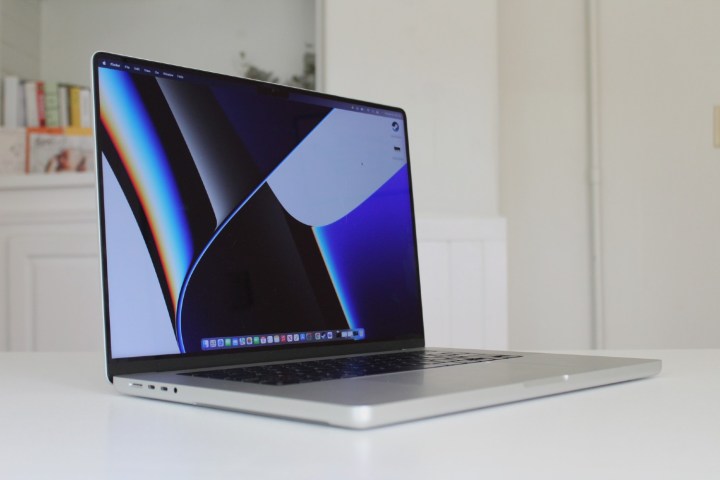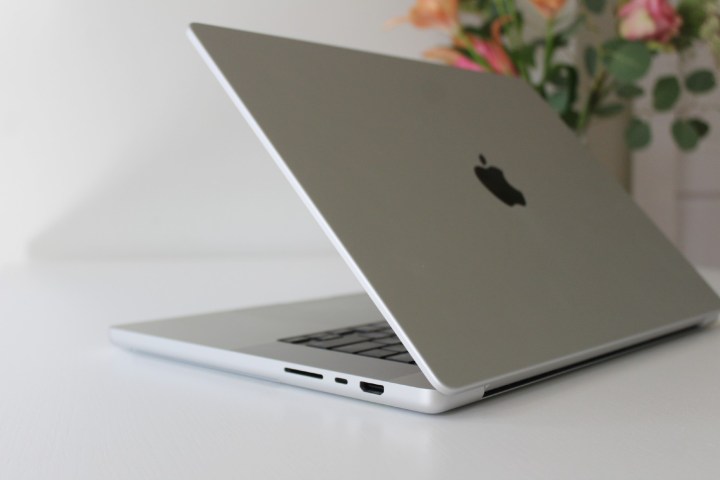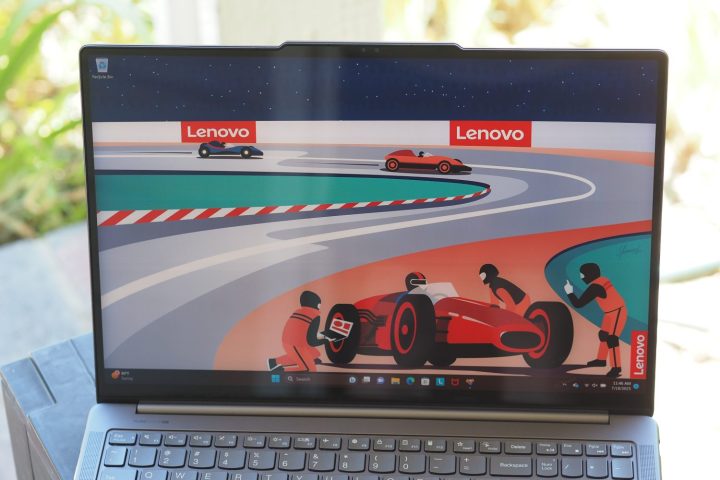
The 16-inch creator’s laptop is increasingly popular, and a number of excellent options have emerged. The Apple MacBook Pro 16 is the premier example, offering a combination of performance, battery life, and quality that’s hard to match.
Lenovo recently upsized its attractive Slim 9i laptop, creating the Slim Pro 9i that packs in a very powerful CPU and a choice of lower-end GPUs. Don’t let the latter fool you, though, as Lenovo has squeezed out a lot of performance. Can the Slim Pro 9i take on the mightly MacBook Air 16?
Specs and configurations
| Lenovo Slim Pro 9i | Apple MacBook Pro 16 | |
| Dimensions | 14.27 inches x 9.64 inches x 0.71 inches | 14.01 inches x 9.77 inches x 0.66 inches |
| Weight | 4.92 pounds | 4.8 pounds |
| Processor | Intel Core i9-13905H | Apple M1 Pro Apple M1 Max |
| Graphics | Nvidia GeForce RTX 4050 Nvidia GeForce RTX 4060 |
Integrated Apple GPU |
| RAM | 32GB LPDDR5X-6400Mhz | 16GB 32GB 64GB (M1 Max) |
| Display | 16.0-inch 16:10 3.2K (3200 x 2000) mini-LED touch, 165Hz | 16.2-inch 16:10 Liquid Retina XDR (3456 x 2234), 120Hz |
| Storage | 1TB PCIe SSD | 512GB SSD 1TB SSD 2TB SSD 4TB SSD 8TB SSD |
| Touch | Yes | No |
| Ports | 1 x USB-C with Thunderbolt 4 2 x USB-A 3.2 Gen 1 1 x HDMI 1 x 3.5mm audio jack 1 x SD card reader |
3 x USB-C 4 with Thunderbolt 4 1 x HDMI 2.0 1 x 3.5mm audio jack 1 x SD Card reader |
| Wireless | Wi-Fi 6E and Bluetooth 5.2 | Wi-Fi 6E and Bluetooth 5.3 |
| Webcam | 5MP with infrared camera for Windows 11 Hello | 1080p |
| Operating system | Windows 11 | MacOS Monterey |
| Battery | 75 watt-hour | 100 watt-hour |
| Price | $1800+ | $2,499+ |
| Rating | 3.5 out of 5 stars | 5 out of 5 stars |
Lenovo’s pricing and configurations can be confusing and they change often. Right now, my review configuration of a Core i9-13905H, 32GB of RAM, a 1TB SSD, a 16.0-inch Mini-LED display, and an Nvidia GeForce RTX 4050 costs $1,800. You can spend $1,545 and drop down to a Core i7-1280P CPU and integrated Intel Iris Xe graphics, but that’s not much of a bargain.
The MacBook Pro 16 is a much more expensive laptop. It starts at $2,499 for an M2 Pro CPU, 16GB of RAM, a 512GB SSD, and a 16.2-inch Mini-LED display. At the high end, you’ll spend a whopping $6,499 for an M2 Max, 96GB of RAM, and an 8TB SSD.
Design

The MacBook Pro 16 offers one of the highest-quality and simplistically elegant chassis around. It’s fabricated from solid chunks of aluminum, and the fit and finish are second to none. It’s a very minimalist design with just the right curves and angles, making it a supremely elegant laptop. Even with a large 16.2-inch display, it’s reasonably wide and deep thanks to small display bezels and it’s relatively thin and light at 0.66 inches and 4.8 pounds. The only feature that stands out in a negative way, for some people, is the notch at the top of the display that makes room for the 1080p webcam.
The Slim Pro 9i is also well-built, although not quite as solid as the MacBook. It’s also minimalist in its design, and benefits from comfortable rounded edges that look and feel great. It’s also an attractive laptop, and you’d be hard-pressed to choose between these two laptops on looks alone. It’s about the same width and depth as the MacBook Pro 16 while being a bit thicker and heavier at 0.71 inches and 4.92 pounds. Lenovo’s approach to using thin display bezels but still packing in a high-quality 5MP webcam and infrared camera is its iconic reverse notch, which some people might prefer.
The MacBook Pro 16’s keyboard is the best you’ll find on a laptop today, with excellent keycap size, key spacing, and the crispest, most precise switches. Its spacious Force Touch haptic touchpad is also the best you can buy, with a natural feel and excellent features. The Slim Pro 9i’s keyboard is good enough and its touchpad is fine. But Apple wins here.
Both laptops have decent connectivity, with the MacBook packing in more Thunderbolt 4 support and the Slim Pro 9i offering a couple of USB-A ports. Both offer the latest in wireless connectivity.
In terms of security, the Slim Pro 9i offers Windows 11 Hello facial recognition and a switch to electronically turn off the webcam. The MacBook Pro 16 has Apple’s Touch ID fingerprint sensor.
Performance

The Slim Pro 9i uses the 45-watt 13th-gen Intel Core i9-13905H CPU, a 14-core (six Performance and eight Efficient), 20-thread CPU that provides excellent CPU-intensive performance. The latest MacBook Pro 16 offers either an M2 Pro or M2 Max, with the former featuring 12 CPU cores and 19 GPU cores and the latter being configurable up to 12 CPU cores and 38 GPU cores. We tested the previous model of MacBook Pro 16 with the 10-core CPU/16-core GPU M1 Pro, and so the MacBook Pro 14 with the top-end M2 Max is included as a proxy. Note that the 16-inch model will likely be a bit faster thanks to better thermals.
In our CPU-intensive benchmarks, the Slim Pro 9i was faster than the MacBook Pro 14 M2 Max in all but Geekbench 5. Looking at the Pugetbench Premiere Pro benchmark that runs in a live version of Adobe’s Premiere Pro and uses the GPU to speed up various tasks, the Lenovo again took the lead in performance mode. That’s surprising given the entry-level Nvidia GeForce RTX 4050 GPU in the Slim Pro 9i and demonstrates that Apple’s M2 Max CPU isn’t necessarily a better option than a Windows laptop with a discrete GPU.
Both laptops are incredibly fast for the most demanding productivity tasks, and both can handle high-end creative workflows.
| Geekbench (single/multi) |
Handbrake (seconds) |
Cinebench R23 (single/multi) |
Pugetbench Premiere Pro |
|
| Lenovo Slim Pro 9i (Core i9-13905H / RTX 4050) |
Bal: 1688 / 13283 Perf: 1667 / 13884 |
Bal: 71 Perf: 63 |
Bal: 1690 / 16645 Perf: 1691 / 18085 |
Bal: 912 Perf: 1114 |
| MacBook Pro 16 (M1 Pro 10/16) |
Bal: 1707/ 12605 Perf: N/A |
Bal: 95 Perf: N/A |
Bal: 1531 / 12343 Perf: N/A |
Bal: 977 Perf: N/A |
| MacBook Pro 14 M2 (M2 Max 10/38) |
Bal: 1668 / 14422 Perf: N/A |
Bal: 85 Perf: N/A |
Bal: 1608 / 14789 Perf: N/A |
Bal: 1093 Perf: N/A |
Display and audio

Both laptops use the newest display technology, Mini-LED, but each company’s implementation of it was a bit different. The Slim Pro 9i had impressive brightness, one of the highest scores we’ve recorded, and was much brighter than the MacBook Pro in standard XDR mode. Both can likely go brighter when running high dynamic range (HDR) content, something we know the MacBook Pro 16 is capable of, but we don’t measure that. Both laptops had similar color widths and accuracy and are good but not great for creators.
The MacBook Pro 16, though, had a much higher contrast ratio and display inkier blacks by default. That makes it a more attractive display overall. When we switch the Slim Pro 9i to HDR mode in Windows, its contrast rose to about the same level but its colors and brightness were both reduced. So, Apple is doing a better job of optimizing its Mini-LED panel than Lenovo. Note that the Slim Pro 9i’s panel runs at up to 165Hz compared to the MacBook Pro 16’s 120Hz.
Nevertheless, both displays are great for productivity work and very good for creative apps. The MacBook Pro 16 is the king of HDR content, though.
| Lenovo Slim Pro 9i (Mini-LED) |
Apple MacBook Pro 16 (Mini-LED) |
|
| Brightness (nits) |
675 | 475 |
| AdobeRGB gamut | 88% | 90% |
| sRGB gamut | 100% | 100% |
| Accuracy (DeltaE, lower is better) |
1.24 | 1.04 |
| Contrast ratio | 3,090:1 | 475,200:1 |
The MacBook Pro 16 features six speakers with force-canceling woofers, and quite frankly produces the best audio on a laptop today. There’s tons of volume, crisp mids and highs, and more bass than you expect on a laptop. It’s a great experience. The headphone jack can also drive high-impedance headphones. The four speakers on the Slim Pro 9i are fine, but they don’t really compare to the MacBook Pro 16’s experience.
Portability

Both laptops are larder machines, and you’ll feel both in your backpack. But the MacBook Pro 16 is slightly more svelte.
Mainly, though, the MacBook Pro 16 stands out because of the incredible efficiency that goes with its excellent performance. Even with a power-hungry Mini-LED display, and thanks to 100 watt-hours of battery capacity, the MacBook Pro 16 doubled up on the Slim Pro 9i in our web browsing and video looping tests. The Slim Pro 9i suffered from just a 75-watt-hour battery, but that’s not enough to account for the massive difference. Apple’s Silicon chips are just incredibly more efficient than Intel’s.
You’ll get a couple of days of normal use out of the MacBook Pro 16 on a single charge, while you’ll be reaching for the Slim Pro 9i’s charger by lunchtime. Apple’s laptop provides an impressive combination of performance and battery life that Windows laptops simply can’t match.
| Lenovo Slim Pro 9i (Core i9-13905H) |
Apple MacBook Pro 16 (M2 Pro) |
|
| Web browsing | 4 hours, 59 minutes | 9 hours 18 minutes |
| Video | 9 hours, 18 minutes | 23 hours 11 minutes |
The MacBook Pro 16 is a more refined laptop
The Slim Pro 9i is a solid example of a 16-inch laptop with a great display and enough performance to meet demanding creative workflows. It’s also less expensive, but its battery life is poor.
The MacBook Pro 16 is just as fast and offers class-leading battery life, and its design and build are superior. It’s a lot more expensive, but if you can afford it, it’s the more refined choice.
Editors’ Recommendations




